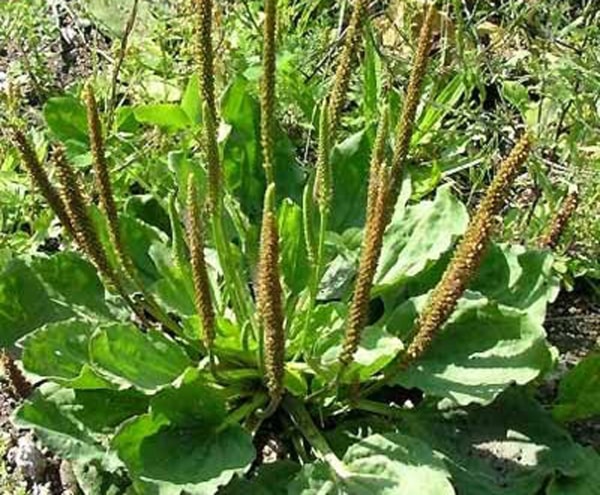In medieval Christian art work, whenever plantain (Plantago spp.) appears in a painting, it represents the well-trodden path of Christ. First Nations called plantain white man’s foot. Once the white man arrived in North America, where ever they walked plantain appeared.
Plantain likes to grow on well-trodden paths. In my garden, plantain dominates in the middle of one garden. It is the path my dog uses to get to the gate barking. No matter how often I tell her to stay out of the gardens, she continually bounds across the garden on her pre-determined route. I thought this was not a good thing, but it has turned out not too bad. On her path to the gate grows some fine looking plantain.
Even though plantain is a hardy, abundant plant, it is not easy to find plants suitable for medicine. Loving to grow underfoot, it is usually ripped, chewed on, dusty and most liked peed on as well. All this make it undesirable for medicine. It is important to always find healthy, clean plants to make medicine with.
It is interesting to consider feet and the medicine of plantain. Feeling the dew on bare toes, or trotting across the road without shoes are simple pleasures summer brings.
However, bare feet tend to find small bits of broken glass or slivers which embed themselves into flesh. Both are a case for plantain.
Plantain has drawing medicine. It pulls venom from insect bites, slivers from fence posts, bits of glass, and small stones from knees after a bike crash.
A woman came to see me with a large, hard bump on her big toe. The doctor did not know what it was. Seeing nothing but the bump, I did not know what it was. However, the number one principle in herbal medicine is: Keep It Simple. Applying this principle I thought, “Feet step on things and plantain pulls things.” I gave her a tincture of fresh plantain and showed her how to dab some on a piece of cotton batting, cover the bump, and fix it with tape. I instructed her to change it every three hours. In two days, a large black sliver came out and that was the end of the bump on her toe.
A spit poultice of plantain can also be used in cases of emergency. Find a couple of fresh looking leaves, chew them up and plaster over a sting or sliver. Saliva will break down the cell membranes within the leaves. This releases the medicine contained within the cells. Be sure to change the spit poultice several times during the day.
Aboriginal people around the world prepared plant medicine by chewing on the leaves, roots or seeds. On the Polynesian Islands, the peaceful kava (Piper mysticum) plant is prepared in two parts. First, the root is cut into bite size pieces. Then it is chewed by virgins until it is mush. The mush is then spit into a bowl and shared by the community. Mostly it is recorded that the Polynesians believed the virgins’ purity was necessary for good medicine. But I suspect that keeping the teenagers mellow and occupied was useful to the community. Aristotle concluded more than 2,300 years ago that “the young are heated by Nature as drunken men by wine.”
Modern herbalists gently heat water or maceration plants in alcohol to make medicine.
However, most herbalists have their feet rooted in tradition. My husband cringes when I chew up plantain and slather it over his bites, burns and slivers.
Plantain is extremely useful for afflictions to the mouth.
The root is chewed to relieve toothaches while the drawing power of the leaf clears pus and helps heal an abscess. Gargling with a strong infusion of plantain heals gingivitis.
Doctor Christopher, a famous American herbalist, used plantain to draw embedded ear wax. Dab fresh tincture on cotton batting, gently place in the ear over night, and in the morning hearing is as clear as a bell.
Because plantain grows so close to humans, it is considered a friendly plant by herbalists. Friendly plants like plantain always have many ways to help humans, whether the humans know it or not. Step outside, what plant is growing near the door step. Perhaps it has medicine to offer.
Herbs for Life is written by Abrah Arneson, a local clinical herbalist. It is intended for information purposes only. Readers with a specific medical problem should consult a doctor. For more information, visit www.abraherbalist.ca. Arneson can be reached at abrah@shaw.ca
